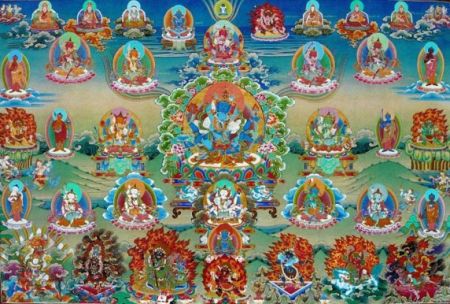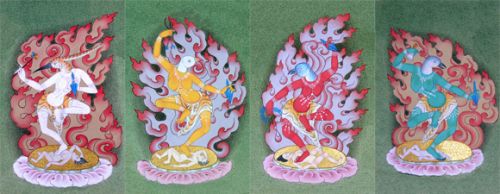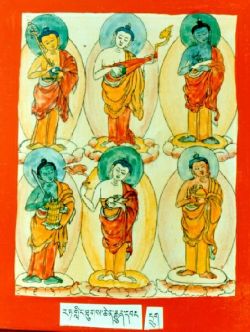「Hundred peaceful and wrathful deities 文武百尊/靜忿百尊/寂忿百尊」修訂間的差異
SSTC Bubble(對話 | 貢獻) 小 (已匯入 1 筆修訂) |
SSTC Bubble(對話 | 貢獻) |
||
| (未顯示由 2 位使用者於中間所作的 3 次修訂) | |||
| 行 1: | 行 1: | ||
The '''Hundred Peaceful and Wrathful Deities''' (Tib. ཞི་ཁྲོ་རིགས་བརྒྱ་, [[Wyl.]] ''zhi khro rigs brgya'') include the [[forty-two peaceful deities]] and [[fifty-eight wrathful deities]]. They feature in several practices and cycles of teachings, most notably the ''[[Tibetan Book of the Dead]]'' and the [[Guhyagarbha Tantra]], which is the primary source describing this [[mandala]]. | The '''Hundred Peaceful and Wrathful Deities''' (Tib. ཞི་ཁྲོ་རིགས་བརྒྱ་, [[Wyl.]] ''zhi khro rigs brgya'') include the [[forty-two peaceful deities]] and [[fifty-eight wrathful deities]]. They feature in several practices and cycles of teachings, most notably the ''[[Tibetan Book of the Dead]]'' and the [[Guhyagarbha Tantra]], which is the primary source describing this [[mandala]]. | ||
| − | ==Forty-two Peaceful Deities== | + | 文武百尊共有42位寂靜尊與58位忿怒尊,見於諸多的修持與教法中,其中最著名的乃是《中陰聽聞得度》和《秘密藏續》兩部,皆為描述此壇城的重要依據。 |
| + | |||
| + | ==Forty-two Peaceful Deities 四十二位寂靜尊== | ||
[[Image:Peaceful guhyagarbha.JPG|thumb|450px|Thangka representing the [[forty-two peaceful deities]]]] | [[Image:Peaceful guhyagarbha.JPG|thumb|450px|Thangka representing the [[forty-two peaceful deities]]]] | ||
| − | {{:Forty-two peaceful deities}} | + | {{:Forty-two peaceful deities 四十二寂靜尊(文武百尊之「文尊」)}} |
| − | ==Fifty-eight Wrathful Deities== | + | ==Fifty-eight Wrathful Deities 五十八位忿怒尊== |
| − | {{:Fifty-eight wrathful deities}} | + | {{:Fifty-eight wrathful deities 五十八忿怒尊}} |
==Further Reading== | ==Further Reading== | ||
於 2021年2月8日 (一) 18:40 的最新修訂
The Hundred Peaceful and Wrathful Deities (Tib. ཞི་ཁྲོ་རིགས་བརྒྱ་, Wyl. zhi khro rigs brgya) include the forty-two peaceful deities and fifty-eight wrathful deities. They feature in several practices and cycles of teachings, most notably the Tibetan Book of the Dead and the Guhyagarbha Tantra, which is the primary source describing this mandala.
文武百尊共有42位寂靜尊與58位忿怒尊,見於諸多的修持與教法中,其中最著名的乃是《中陰聽聞得度》和《秘密藏續》兩部,皆為描述此壇城的重要依據。
目錄
- 1 Forty-two Peaceful Deities 四十二位寂靜尊
- 1.1 1) Samantabadra 普賢王如來
- 1.2 2) Samantabadri 普賢王如來佛母
- 1.3 3-7) The Five Male Buddhas of the Five Families 五方佛
- 1.4 8-12) The Five Female Buddhas of the Five Families 五方佛母
- 1.5 13-20) The Eight Male Bodhisattvas 八大菩薩
- 1.6 21-28) The Eight Female Bodhisattvas 八大女菩薩/八大供養天女
- 1.7 29-34) The Six Munis 六能仁
- 1.8 35-38) The Four Male Gate Keepers 護門四王
- 1.9 39-42) The Four Female Gate Keepers 四守門女/四方守護明母
- 2 Fifty-eight Wrathful Deities 五十八位忿怒尊
- 2.1 1-10) The Five Wrathful Herukas and their Five Consorts 五大飲血尊(赫魯迦或嘿嚕嘎)佛父母
- 2.2 11-18) The Eight Wrathful Females 八忿怒母
- 2.3 19-26) The Eight Tramen 八獸首母
- 2.4 27-30) The Four Female Gatekeepers 四門守護母
- 2.5 31-58) The Twenty-eight Ishvaris 二十八自在母
- 2.6 59-60) Chemchok Heruka and his Consort 千秋飲血尊(大殊勝赫魯迦或大殊勝嘿嚕嘎)佛父母
- 3 Further Reading
Forty-two Peaceful Deities 四十二位寂靜尊

The forty-two peaceful deities (Tib. shyiwé lha shyé nyi; Wyl. zhi ba'i lha zhe gnyis) are:
1) Samantabadra 普賢王如來
Samantabhadra 普賢王如來 (Wyl. kun tu bzang po);
2) Samantabadri 普賢王如來佛母
Samantabhadri 普賢王如來佛母 (Wyl. kun tu bzang mo);
3-7) The Five Male Buddhas of the Five Families 五方佛
Buddhas of the five families (Skt. jinakula; Tib. རྒྱལ་བ་རིགས་ལྔ་, Wyl. rgyal ba rigs lnga) — the five peaceful buddhas of the Sambhogakaya: 五佛部之佛-五位寂靜相報身佛。
- Vairochana, buddha family 毘盧遮那佛/大日如來,佛部
- Akshobhya, vajra family 阿閦佛/不動佛,金剛部
- Ratnasambhava, ratna family 寶生佛,寶部
- Amitabha, padma family 阿彌陀佛/無量光佛,蓮華部
- Amoghasiddhi, karma family 不空成就佛,事業部/羯摩部
8-12) The Five Female Buddhas of the Five Families 五方佛母
The five female buddhas of the five families, also known as the five mothers (Wyl. yum lnga) are:
- Dhatvishvari 金剛界自在母(大日如來佛母) (Skt.; Tib. དབྱིངས་ཕྱུག་མ་, Ying Chukma) also known as Vajra Datvishvari or White Tara, the consort of Vairochana, who represents the purity of the element space(大日如來佛母),或說白度母,空大的淨相
- Buddhalochana 慧眼佛母(不動佛的佛母) (Skt.; Tib. སངས་རྒྱས་སྤྱན་, Sangyé chenma) the consort of Akshobhya, who represents the purity of the element earth(阿閦佛佛母),地大的淨相
- Mamaki 瑪瑪姬佛母(寶生佛佛母) (Skt.; Tib. མ་མ་ཀི་, Mamaki) the consort of Ratnasambhava, who represents the purity of the element water(寶生佛佛母),水大的淨相
- Pandaravasini 白衣佛母(阿彌陀佛佛母) (Skt.; Tib. གོས་དཀར་མོ་, Gökarmo) the consort of Amitabha, who represents the purity of the element fire(阿彌陀佛佛母),火大的淨相
- Samayatara 三昧耶度母 (Skt.; Tib. དམ་ཚིག་སྒྲོལ་མ་, Damtsik Drolma) also known as Green Tara, the consort of Amoghasiddhi, who represents the purity of the element wind(不空成就佛佛母),或說綠度母,風大的淨相
13-20) The Eight Male Bodhisattvas 八大菩薩
Eight Great Bodhisattvas, or 'Eight Close Sons' (Skt. aṣṭa utaputra; Tib. ཉེ་བའི་སྲས་བརྒྱད་, Wyl. nye ba'i sras brgyad) — the main bodhisattvas in the retinue of Buddha Shakyamuni:
| This section contains Tibetan script. Without proper Tibetan rendering support configured, you may see other symbols instead of Tibetan script. |
- Mañjushri, འཇམ་དཔལ་ or འཇམ་དཔལ་དབྱངས་ 文殊師利(妙吉祥)菩薩,
- Avalokiteshvara, སྤྱན་རས་གཟིགས་ 觀世音菩薩,
- Vajrapani, ཕྱག་ན་རྡོ་རྗེ་ 金剛手(大勢至)菩薩,
- Maitreya, བྱམས་པ་མགོན་པོ་ 彌勒菩薩,
- Kshitigarbha, ས་ཡི་སྙིང་པོ་ or སའི་སྙིང་པོ་ 地藏菩薩,
- Akashagarbha, ནམ་མཁའི་སྙིང་པོ་ 虛空藏菩薩,
- Sarvanivaranavishkambhin, སྒྲིབ་པ་རྣམ་སེལ་ 除蓋障菩薩, and
- Samantabhadra, ཀུན་ཏུ་བཟང་པོ་ 普賢菩薩.
Read more about them
21-28) The Eight Female Bodhisattvas 八大女菩薩/八大供養天女
The eight female bodhisattvas (Wyl. byang chub sems ma brgyad) are also referred to as the eight offering goddesses. They are the consorts of the eight great bodhisattvas:
八大菩薩的明妃[譯註:嬉女、鬘女、歌女、舞女、花女、香女、燈女、塗女,皆屬三十七曼達供養]。
- Goddess of Beauty 嬉媚天女(Skt. Lāsyā; Tib. Gekpama; Wyl. sgeg pa ma) the consort of Kshitigarbha 地藏菩薩的明妃,又稱金剛媚母
- Goddess of Garlands 持鬘天女(Skt. Mālyā; Tib. Trengwama; Wyl. phreng ba ma) the consort of Akashagarbha 虛空藏菩薩的明妃,又稱金剛鬘母
- Goddess of Song 歌詠天女(Skt. Gītā; Tib. Luma; Wyl. glu ma) the consort of Vajrapani 金剛手(大勢至)菩薩的明妃,又稱金剛聲母
- Goddess of Dance 舞蹈天女(Skt. Nirtī; Tib. Garma; Wyl. gar ma) the consort of Avalokiteshvara 觀世音菩薩的明妃,又稱金剛舞母
- Goddess of Flowers 供花天女(Skt. Pūṣpā; Tib. Metokma Wyl. me tog ma) the consort of Sarvanivaranavishkambhin 除蓋障菩薩的明妃,又稱金剛華母
- Goddess of Incense 薰香天女(Skt. Dhupā; Tib. Dukpöma; Wyl. bdu spos ma) the consort of Maitreya 彌勒菩薩的明妃,又稱金剛香母
- Goddess of Light 明燈天女(Skt. Alokā; Tib. Marmema or Nangselma; Wyl. mar me ma) the consort of Samantabhadra 普賢菩薩的明妃,又稱金剛燈母
- Goddess of Perfume 塗香天女(Skt. Gandhā; Tib. Drichabma; Wyl. dri chab ma) the consort of Mañjushri 文殊菩薩的明妃,又稱金剛塗母
Symbolically they represent the pure state of sense objects.
象徵感官對境的淨相。
29-34) The Six Munis 六能仁
The Six Munis (Skt.; Tib. Tubpa Druk; Tib. ཐུབ་པ་དྲུག་, Wyl. thub pa drug) are the supreme nirmanakaya buddhas for each of the six classes of beings. They are:
相應度脫六道眾生的無上化身佛。分別是:
- Indra Kaushika 天道能仁─天帝帝釋(Skt.; Tib. དབང་པོ་བརྒྱ་བྱིན་, Wangpo Gyajin; Wyl. dbang po brgya byin) for the god realms
- Vemachitra 非天能仁─綺畫修羅王(毗摩質多)(Skt. Vemacitra; Tib. ཐགས་བཟང་རིས་, Taksangri; Wyl. thags bzang ris) for the demi-gods or asura realms
- Shakyamuni 人道能仁─釋迦牟尼(Tib. ཤཱཀྱ་ཐབ་པ་, Wyl. shAkya thub pa) for the human realm
- Shravasingha or Dhruvasiṃha 旁生道能仁─堅淨師子(Skt.; Tib. སེང་གེ་རབ་བརྟན་, Sengé Rabten; Wyl. seng ge rab brtan) for the animal realm
- Jvālamukhadeva 餓鬼道能仁─焰口天(Skt.; Tib. ཁ་འབར་དེ་བ་, Khabar Dewa; Wyl. kha ‘bar de ba) for the preta realms
- Dharmarāja 地獄道能仁─法王(Skt.; Tib. ཆོས་ཀྱི་རྒྱལ་པོ་, Chökyi Gyalpo; Wyl. chos kyi rgyal po) for the hell realms
[譯註:能仁也可以直接翻譯為佛陀,堅淨一詞出於《地藏占察經》當中「堅淨信菩薩」的譯詞;感謝敦珠貝瑪南嘉師兄指導。2015.05.27更正]
35-38) The Four Male Gate Keepers 護門四王
The four male gatekeepers (Wyl. sgo ba yab bzhi) are:
- Achala, guarding the east gate (or Vijaya, or Mahabala?) 不動明王(或說尊勝明王、大力明王),守護東門
- Yamantaka, guarding the south gate 閻魔敵明王/大威德金剛,守護南門
- Hayagriva, guarding the west gate 馬頭明王,守護西門
- Amritakundali, guarding the north gate 甘露漩明王,守護北門
39-42) The Four Female Gate Keepers 四守門女/四方守護明母
The four female gatekeepers (Wyl. sgo ma bzhi) are:
- Ankusha (Skt. Aṅkuśā; Wyl. lcags kyu ma or rta gdong ma) also called 'Horse Face' or 'Iron Hook', guarding the east gate and in union with Vijaya (or Achala?) 金剛鐵鉤女,又稱馬面或鐵鉤,守護東門,與尊勝明王(或說不動明王)雙運
- Pasha (Skt. Pāśā; Wyl. zhags pa ma or phag gdong ma) also called 'Sow Face' or 'the Noose', guarding the south gate and in union with Yamantaka 金剛繩女,又稱亥母面或繩索套,守護南門,與閻魔敵明王雙運
- Shrinkhala (Skt. Śriṅkhalā; Wyl. lcags sgrog ma or seng gdong ma) also called 'Lion Face' or 'Iron Chain', guarding the west gate and in union with Hayagriva 金剛鐵鍊女,又稱獅面或鐵鍊,守護西門,與馬頭明王雙運
- Ghanta (Skt. Ghaṇtā; Wyl. dril bu ma or spyang gdong ma) also called 'Wolf Face' or 'the Bell', guarding the north gate and in union with Amritakundali. 金剛鈴女,又稱狼面或鈴,守護北門,與甘露漩明王雙運
Fifty-eight Wrathful Deities 五十八位忿怒尊
The fifty-eight wrathful deities are:
1-10) The Five Wrathful Herukas and their Five Consorts 五大飲血尊(赫魯迦或嘿嚕嘎)佛父母
The five wrathful herukas and their five consorts—the wrathful aspect of the buddhas of the five families and of the five female buddhas—are: 五大嘿嚕嘎父母尊乃五方佛父母尊的忿怒相:
- Buddhaheruka and his consort Buddhakrodhishvari 佛部嘿嚕嘎及佛部忿怒界自在佛母;
- Vajraheruka and his consort Vajrarodhishvari 金剛部嘿嚕嘎及金剛部忿怒界自在佛母;
- Ratnaheruka and his consort Ratnarodhishvari 寶生部嘿嚕嘎及寶生部忿怒界自在佛;
- Padmaheruka and his consort Padmakrodhishvari 蓮華部嘿嚕嘎及蓮華部忿怒界自在佛母 and
- Karmaheruka and his consort Karmakrodhishvari 羯磨部(事業部)嘿嚕嘎及羯磨部忿怒界自在佛母.
11-18) The Eight Wrathful Females 八忿怒母
The eight wrathful females or eight gaurima (Skt. gaurī; Tib. gaurima; Wyl. gau ri ma brgyad) are: [譯註:八菩薩的忿怒相]
- Gauri (Skt. Gaurī; Wyl. ko'u ri) 郭日瑪
- Pukkasi (Skt. Pukkasī; Wyl. pus ka si) 布噶西
- Chaurimatrika (Skt. Caurī; Wyl. tso'u ri) 橋日瑪赤卡
- Ghasmari (Skt. Ghasmarī; Wyl. kas ma ri) 噶斯瑪日
- Pramoha (Skt. Pramohā; Wyl. pra mo) 巴拉摩哈
- Chandali (Skt. Caṇḍālī; Wyl. tsan dha li) 千答里
- Vetali (Skt. Vetālī; Wyl. be'e ta li) 毘答里
- Shmashani (Skt. Śmaśānī; Wyl. sme sha ni) 美夏尼
19-26) The Eight Tramen 八獸首母
The eight tramen (Wyl. phra men brgyad; Skt. piśacī), or eight singhama (Wyl. sim ha brgyad) are animal-headed deities (tramen literally means 'hybrid'). They are: 屬於五十八忿怒尊中,面首為動物的本尊
- Simhamukha (Skt. Siṃhamukhā) 獅首母
- Vyaghrimukha (Skt. Vyāghramukhā) 虎首母
- Srigalamukha (Skt. Śṛgālamukhā) 狐首母
- Shvanamukha (Skt. Śvanmukhā) 狼首母
- Gridhamukha (Skt. Gṛdhramukhā) 鷲首母
- Kangkamukha (Skt. Kaṅkamukhā; Wyl. kang ka mu kha), dark red in colour with a kite's/heron's (?) (Skt. kaṅka) head 赤雞首母(蒼鷲頭母)
- Kakamukha (Skt. Kākamukhā) 鴉首母
- Ulumukha (Skt. Ulūkamukhā) 梟/鴞首母
27-30) The Four Female Gatekeepers 四門守護母
The four female gatekeepers (Wyl. sgo ma bzhi) are:
- Ankusha (Skt. Aṅkuśā; Wyl. lcags kyu ma or rta gdong ma) also called 'Horse Face' or 'Iron Hook', guarding the east gate and in union with Vijaya (or Achala?) 金剛鐵鉤女,又稱馬面或鐵鉤,守護東門,與尊勝明王(或說不動明王)雙運
- Pasha (Skt. Pāśā; Wyl. zhags pa ma or phag gdong ma) also called 'Sow Face' or 'the Noose', guarding the south gate and in union with Yamantaka 金剛繩女,又稱亥母面或繩索套,守護南門,與閻魔敵明王雙運
- Shrinkhala (Skt. Śriṅkhalā; Wyl. lcags sgrog ma or seng gdong ma) also called 'Lion Face' or 'Iron Chain', guarding the west gate and in union with Hayagriva 金剛鐵鍊女,又稱獅面或鐵鍊,守護西門,與馬頭明王雙運
- Ghanta (Skt. Ghaṇtā; Wyl. dril bu ma or spyang gdong ma) also called 'Wolf Face' or 'the Bell', guarding the north gate and in union with Amritakundali. 金剛鈴女,又稱狼面或鈴,守護北門,與甘露漩明王雙運
31-58) The Twenty-eight Ishvaris 二十八自在母
The twenty-eight ishvaris (Skt. īśvarī; Tib. wangchukma nyer gyé; Wyl. dbang phyug ma nyer brgyad)
The twenty-eight ishvaris are composed of four groups of six yoginis corresponding to the four activities, and of the four female outer-gate keepers:
相應於[息增懷誅]四事業的四類瑜伽母,各有六位,再加上四位外門的守護母,共計廿八位自在母
1. The six yoginis corresponding to the activity of pacifying:
相應於息災事業的六瑜伽母

- Rakshasi (white) 白羅刹天/牛頭羅剎女
- Brahmi 梵天/蛇頭梵天女
- Mahadevi 大天/豹頭大天女
- Lobha 大自在天
- Kumari 童子天
- Indrani 帝釋天/熊頭帝釋女
2. The six yoginis corresponding to the activity of increasing:
相應於增益事業的六瑜伽母

- Vajra 金剛/金剛蝙蝠頭女
- Shanti 寂天/寂魔羯頭女
- Amrita 甘露/甘露蠍面女
- Chandra 太陰/月鷂頭女
- Danda 遍入天/棍狐面女
- Rakshasi (dark yellow) 深黃羅刹/虎面羅剎女
3. The six yoginis corresponding to the activity of magnetizing:
相應於懷愛事業的六瑜伽母

- Bhakshini 食者/深鷲頭女
- Rati 歡喜者/喜馬面女
- Mahabala 大力者/大勢鵬面女
- Rakshasi (pale red) 淡紅羅刹/狗面羅剎女
- Kama 欲樂/欲帶勝鳥面女
- Vasuraksha 護財/守財鹿頭女
4. The six yoginis corresponding to the activity of subjugating:
相應於誅伏事業的六瑜伽母

- Vayudevi 風天/風神狼頭女
- Nari 婦女/火母野羊頭女
- Varahi 亥母女/豬首女
- Nanda 金剛(匕首)/金剛侏鴉頭女
- Mahahastini 鼻者/長鼻象頭女
- Varunadevi 水天/水神蛇面女
5. The last group is composed of the four female outer-gate keepers.
四外門守護女

[譯註:東門:白金剛杜鵑首母,持鉤;南門:黃金剛山羊首母,持索;西門:紅金剛獅子首母,持鎖;北門:綠金剛蟒蛇首母,持鈴。]
59-60) Chemchok Heruka and his Consort 千秋飲血尊(大殊勝赫魯迦或大殊勝嘿嚕嘎)佛父母
The fifty-eight wrathful deities become sixty when you add Chemchok Heruka (Wyl. che mchog heruka) and his consort Krodhishvari, who are the wrathful aspects of Samantabhadra and Samantabhadri.
若將五十八位忿怒尊加上普賢佛父母的忿怒相:大殊勝飲血尊與忿怒界自在佛母,則為六十尊。
Further Reading
- Sogyal Rinpoche, The Tibetan Book of Living and Dying, revised and updated edition (Harper San Francisco, 2002), page 284.
